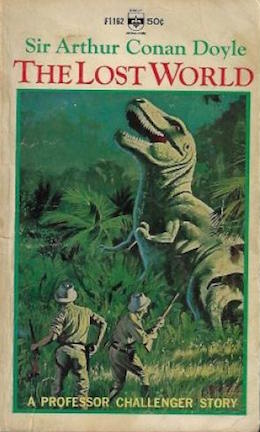In this bi-weekly series reviewing classic science fiction and fantasy books, Alan Brown looks at the front lines and frontiers of the field; books about soldiers and spacers, scientists and engineers, explorers and adventurers. Stories full of what Shakespeare used to refer to as “alarums and excursions”: battles, chases, clashes, and the stuff of excitement.
Today we’ll be going on an adventure with the best character ever created by Arthur Conan Doyle. And I’m not talking about a detective. We’re going to be following the vain, volatile, and brilliant Professor Challenger as he and his plucky companions travel up the Amazon River to a remote plateau where creatures from prehistoric times still walk among more modern beasts. A land filled with exciting discoveries, but also deadly danger. The land of The Lost World.
I know I’m in the minority with my lack of love for Sherlock Holmes. I see the attraction, as his stories are fascinating puzzles, and his deductive powers are remarkable. But the character himself strikes me as passionless. The IBM 360s I worked with in college were remarkable reasoning machines, but watching them work was about as interesting as watching paint dry. I would actually rank Holmes third among my favorite Doyle protagonists, with Sir Nigel of The White Company coming in second. By a long shot, my favorite is Professor George Edward Challenger, a brilliant man himself, but one whose heart is worn on his sleeve. He is deeply flawed: vain, arrogant, and quick to anger—but those flaws also make him a fascinating character, one whose volatility makes his every interaction exciting and unpredictable. He is also remarkable physically, a powerful bull of a man, and utterly unique in the stuffy scientific circles of the early 20th century. His character fairly leaps off page to grab the reader by the scruff of the neck and drag them into the story.
About the Author
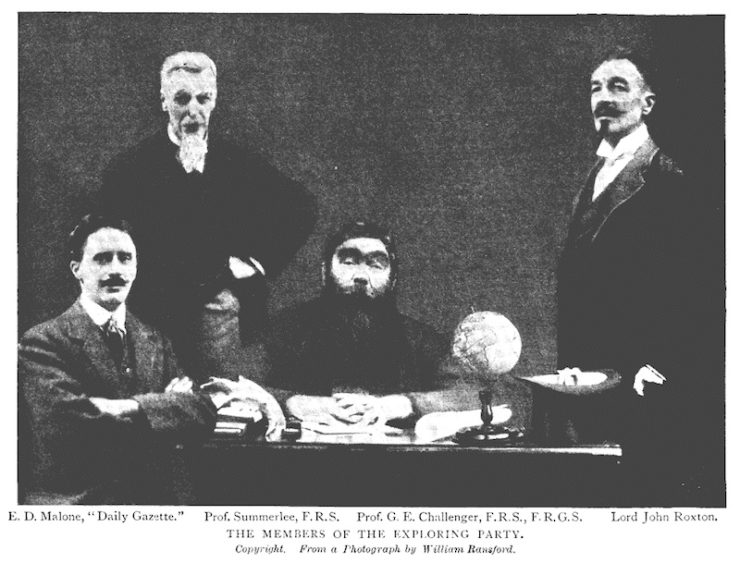
Arthur Conan Doyle (1859-1930) is one of the most widely-known British authors of popular fiction. From the picture above, it might look like I have replaced the normal author’s photograph with an illustration from The Lost World, but that is actually Doyle himself, playing the role of Professor Challenger with a fake beard and eyebrows. A similar picture of Challenger adorned the first edition of the book.
Doyle was trained as a doctor and practiced aboard ships before settling on a practice ashore. His first success as a writer involved the adventures of Sherlock Holmes, but he also wrote a number of historical novels in which he reportedly took greater pride. Among these were The White Company and Sir Nigel, tales of knightly adventure that are well respected, although today not widely known. His writing spanned many genres, and in addition to detective tales, science fiction, and historical fiction, also included non-fiction, humor, poetry and even romance. He was raised Catholic, but in later years drifted away from the faith and became interested in the paranormal and spiritualism. Just as Doyle modeled Sherlock Holmes on an Edinburgh University teacher named Joseph Bell, Challenger was reportedly modeled on physiology professor William Rutherford. The character’s adventures were also inspired by a friend of Doyle’s, Percy Fawcett, an explorer who spent extensive time in the Amazon basin. Professor Challenger featured in two other novels and a pair of short stories, but none of these later adventures were on par with the original book.
Our Enduring Fascination with Dinosaurs

Man has long known of fossil remains of giant creatures, unlike those who walk the earth today. In China, the remains were interpreted as evidence of ancient dragons. Some Europeans speculated that they provided proof of the ancient race of giants mentioned in the Bible. As the Scientific Revolution took hold, however, especially in England, more careful study began to reveal the true nature of these creatures. In the early 19th century, both the Megalosaurus and Iguanodon were described in scientific journals. In 1842, the term “dinosaur” was coined by English paleontologist Richard Owen to collectively describe these creatures. Also in the mid-19th century, this scientific endeavor spread to the United States, and soon there was a race among paleontologists to find bones and identify new species, and to explain the disappearance of these beasts. The efforts of these scientists caught the imagination of the public, new discoveries continued to appear decade after decade, and to this day there is a widespread fascination with these mighty creatures—a fascination that still packs the theaters with each new Jurassic World movie.
My own fascination with dinosaurs was born during a summer in which I spent two weeks in New York City with an uncle who was working for Ford Motor Company at their pavilion at the 1964/1965 World’s Fair. During that time, my aunt took us to the American Museum of Natural History, where I saw the actual bones of a variety of prehistoric creatures. At the fair, Sinclair Oil had a Dinoland full of life-sized dinosaur statues, and would create an injection molded brontosaurus for you on the spot to demonstrate their plastic products. But the most spectacular dinosaurs were in the Ford Pavilion—audio-animatronic dinosaurs who moved as if they were real, and made you feel as if you had actually traveled back to prehistoric times. It was my first exposure to the Disney technology now used at their theme parks around the world, and it made a big impression on me. I laid my hands on every dinosaur book I could find (the Prehistoric Animals book shown above was one of them). When a Scholastic Book catalog from school drew my attention to a book in which hunters were facing off with a Tyrannosaurus, I was sold—and soon owned a copy of The Lost World.
Lost Worlds in Other Media and Other Hands
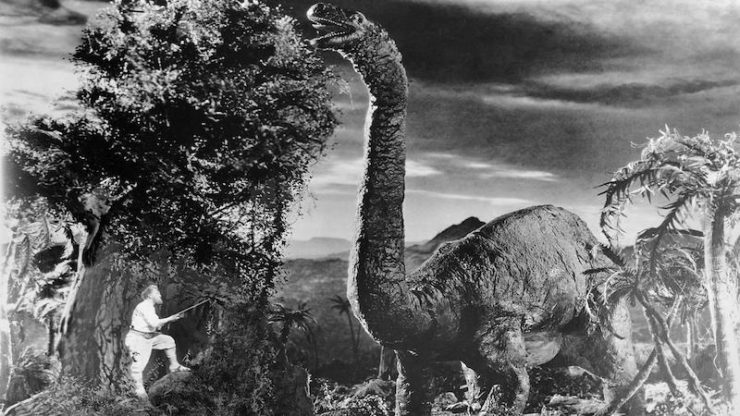
Since it first appeared in 1912, The Lost World has had a lasting impact on film and literature. The book has been turned into four feature films, in 1925, 1960, 1992, and 1998. The 1925 movie used innovative stop-motion effects (the uncredited work of a young Willis H. O’Brien), and with its far-off locale and giant creatures, was a clear inspiration for later movies like King Kong and Mighty Joe Young. The 1960 version was directed by noted science fiction producer Irwin Allen, and used close-ups of actual lizards as rather unconvincing stand-ins for dinosaurs. The 1992 movie, which was followed by a sequel Return to the Lost World in the same year, was notable in that it starred John Rhys-Davies, an actor who in his physical appearance and exuberance was a good match for the role of Professor Challenger. The 1998 movie took some liberties with the story, moving the plateau from the Amazon to Mongolia, and the period to the 1930s.
There was also a television series inspired by the book, an Australian production that ran for three seasons between 1999 and 2002. This series was somewhat campy, taking great liberties with the original story, and featured a scantily clad blonde woman who had been stranded on the plateau as a youngster and now acted as a guide for the explorers. While it was often fun to watch, the quality of the story suffered as the show became ever more fanciful in later seasons.
At the same time that the Australian series was running, the BBC also produced a TV movie version in 2001 that starred Bob Hoskins as Challenger.
Doyle’s The Lost World was also a clear inspiration for author Michael Crichton’s books Jurassic Park and The Lost World. Crichton’s books had the dinosaurs recreated by scientists in laboratories and showcased as the main attraction in a wildlife park that soon spun wildly out of control. In the wildly popular feature film series based on the books, the first of which was directed by Steven Spielberg, the special effects were finally able to create utterly convincing dinosaurs that looked like they had been filmed from real life.
There have been many works by other authors over time, including pastiches and sequels, which were inspired by Professor Challenger and The Lost World. If you’re interested in further reading, Wikipedia has a helpful list that can be found here.
The Lost World
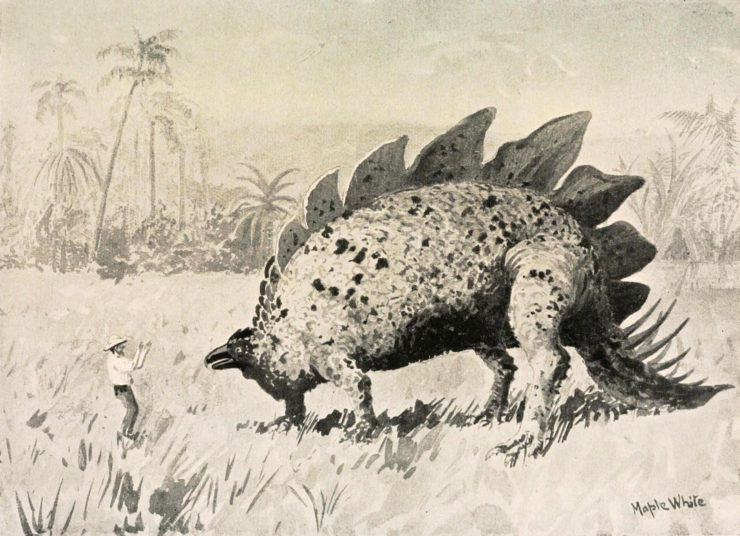
The book opens with a marriage proposal. Ignoring signs that his beloved Gladys is somewhat cold, young newspaper reporter Edward Malone charges right in and pops the question, only to be rebuffed. Gladys does not want any ordinary man as a mate; instead, she wants someone notable, an adventurer, someone whose fame will make her an object of envy. Like many smitten young men, Malone takes her at her word, and asks his editor McArdle for not just a story to follow, but a mission, something filled with danger and adventure. This request leads McArdle to think of Professor Challenger, a somewhat disreputable scientist who has recently returned from South America with wild tales involving strange beasts and a mysterious plateau.
Malone consults with a scientific friend, who warns him to stay away from Challenger, a vain and touchy man. But the reporter does not heed this warning, and when he calls on the Professor, he finds an astonishingly unique man who looks nothing like a sage or scholar: short, but heavily muscled with a barrel chest, and a great profusion of black hair, including a long, flowing beard. The Professor, who has been branded a liar from all corners, especially the press, sees through Malone’s pretext of being a student, and when Malone mentions South America, he flies into a rage and attacks him. The two tumble out of the house, and when a policeman intervenes, Malone tells him he has no interest in making any charges. Impressed by this, Challenger invites him to attend a lecture that evening at the Zoological Institute, where he plans to challenge the presenter with his ideas.
At the lecture, after Challenger disrupts the proceedings, expounding upon his discoveries, a Professor Summerlee is goaded into volunteering to travel to the Amazon to confirm his claims. A noted explorer and hunter, Lord John Roxton, also volunteers to go, as does Malone, who has found his dangerous mission. Malone gets the support of his paper, and his series of dispatches to McArdle give form to the book. The three men outfit themselves and head off to South America with sealed directions from Challenger. Both Summerlee and Roxton have experience with expeditions: Summerlee had traveled to Papua in his younger days, and Roxton is well acquainted with the Amazon, having devoted himself to eradicating a local slave trade in past years. When they arrive, however, they find the sealed envelope empty. Challenger himself arrives to lead them the rest of the way, unwilling to let others explore his lost land without him.
They are guided by maps, notes, and sketches left by an American explorer, Maple White, whose trail Challenger had followed during his previous trip, only to find White recently dead. It was White who first discovered the plateau, leaving behind some intriguing sketches of strange beasts. The team’s expedition expands to include local guides Gomez and Manuel, a powerful black man named Zambo, and several unnamed “Indians” from local tribes.
Upon reaching the plateau, they that find the cave White had used to visit the summit has collapsed. Near the plateau, there is a large pinnacle that is climbable and topped by a massive tree, which they cut down so that it falls toward the plateau and forms a bridge. The four Englishmen equip themselves and cross over, only to have Gomez knock the tree loose, collapsing their bridge. Gomez turns out to be the brother of one of the slavers that Roxton killed during his previous adventures in the Amazon region. Roxton shoots Gomez, and Manuel flees along with most of their party. The loyal Zambo remains near the pinnacle, and sends one of the remaining “Indians” with dispatches from Malone, and a plea for help.
The four men construct a laager using thorn bushes to protect themselves from the wild, and begin to explore their surroundings. They have encounters with a wide variety of creatures from both prehistoric and modern times. Prehistoric creatures that are familiar to us include representatives of the pterodactylus, Iguanodon, Stegosaurus, and plesiosaur species. One creature whose description was unfamiliar to me was a fierce four-legged carnivore, which some research told me was a Megalosaurus. While scientists now know it to be a biped, at the time Doyle was writing, it was thought to be a quadruped. The men also encounter ape-men who appear to be a missing link between apes and humans, and also “Indians” who seem to have arrived on the plateau in more recent years.
I will not dwell on the details of their adventures, as to do so would spoil the fun for those who haven’t read the book. I do, however, want to discuss the ending, so those who want to avoid spoilers should skip ahead to the “Final Thoughts” section of this review. Rereading the book now as a mature reader, I see that Doyle warned us what would happen, as a youth the ending came as a complete surprise to me. Malone returns to his beloved Gladys, expecting her to finally agree to marry him…only to find that in his absence, she felt that he had abandoned her and married an ordinary solicitor’s clerk. With nothing to hold him back from further adventure, Malone then agrees to join Roxton in another expedition to the plateau. I might have felt different after puberty, but at the age when I first read The Lost World, this was the best ending I had ever read. So many books ended with the hero gaining the hand of heroine and settling down to a life of wedded bliss, which sounded pretty boring to me at the time. Ending an adventure with the promise of more adventures to come struck me as perfect.
Final Thoughts
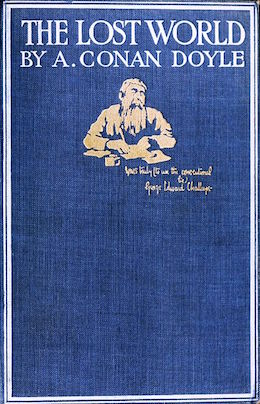 I cannot recommend this book without raising one caveat. At times, the book is marred by the casual racism and sexist attitudes of the times. Gomez and Manuel are introduced to us as “half-breeds,” with an implication that being of mixed blood is an explanation for their treacherous natures. Zambo is unflatteringly described as being as strong and unintelligent as a horse, and as loyal as a dog. The term “Indians” is used for the natives of the Amazon throughout, a sign of indifference to the actual heritage of these people. Only two women are mentioned: Challenger’s wife and the fickle Gladys, and the narrative otherwise reeks of testosterone and maleness. At the same time, however, Doyle seems to be self-aware enough to poke fun at the attitudes of the time. Challenger’s physical appearance, for example, mocks preconceived notions that would equate a certain stereotypical look or appearance with the intelligence necessary to be a scholar or intellectual. And at one point, after making some unflattering comments about the Amazonian natives, Challenger softens those remarks by stating that they are still superior to the average Londoner.
I cannot recommend this book without raising one caveat. At times, the book is marred by the casual racism and sexist attitudes of the times. Gomez and Manuel are introduced to us as “half-breeds,” with an implication that being of mixed blood is an explanation for their treacherous natures. Zambo is unflatteringly described as being as strong and unintelligent as a horse, and as loyal as a dog. The term “Indians” is used for the natives of the Amazon throughout, a sign of indifference to the actual heritage of these people. Only two women are mentioned: Challenger’s wife and the fickle Gladys, and the narrative otherwise reeks of testosterone and maleness. At the same time, however, Doyle seems to be self-aware enough to poke fun at the attitudes of the time. Challenger’s physical appearance, for example, mocks preconceived notions that would equate a certain stereotypical look or appearance with the intelligence necessary to be a scholar or intellectual. And at one point, after making some unflattering comments about the Amazonian natives, Challenger softens those remarks by stating that they are still superior to the average Londoner.
The book, presented as a series of dispatches from Malone to McArdle, follows an epistolary format that was popular at the time. But where other authors let the format dominate the story and give it a stodgy feel, Doyle uses the dispatch format just enough to add a sense of realism, without letting it get in the way of the narrative. The format is also used to add some foreshadowing to events, increasing the overall tension and excitement. Challenger’s vain and volatile personality, and his clashes with the other adventurers (especially Summerlee), add a lot to the narrative, keeping it entertaining throughout. The prose is clear and simple, and the story is always interesting, even when it covers less-action packed sequences, like the team’s preparations for their journey. Once the protagonists reach the plateau, the excitement never flags.
Doyle reportedly did not think of the book as science fiction, but it clearly falls within the genre as we now define it, and indeed, explorers journeying to far-away lands and encounters with prehistoric beasts have become staples within the science fiction genre. This book, in addition to being a fun read, is a valuable resource for those interested in the history of the genre.
And now I turn the floor over to you: Have you read The Lost World, and if so, did you enjoy it as much as I did? How do you think it compares with other works by Doyle? Do you agree with my assertion that Challenger is a character superior to Sherlock Holmes? And where in more recent works do you see the influence of The Lost World?
Alan Brown has been a science fiction fan for over five decades, especially fiction that deals with science, military matters, exploration and adventure.










